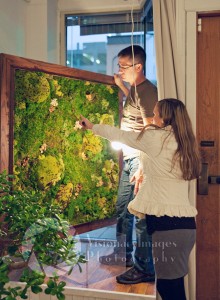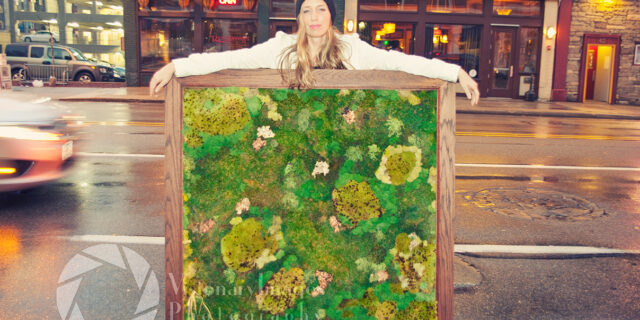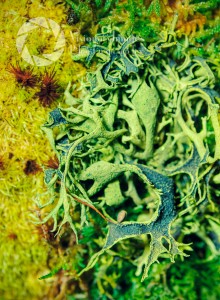 Last week on Friday, Grand Rapids celebrated the 10th anniversary of Free Radical during its opening night. This annual event preceded ArtPrize and brings together artists and urban spaces along Division, Fulton and Wealthy Sreet. Tomorrow night (Friday November 2nd) marks the closing reception and will include documentation and discourse of all the participating artists and venues. Having participated in several of these events over the years, I am well acquainted with the Free Radical community of artists and business owners who come together to make this a unique and important event that lends our city a helping hand in developing cultural appreciation and community revitalization. This year, I was thrilled to take on the role as one of the documenters, as I was serendipitously (OK, maybe purposely) paired up with Ashley Lieber to document her beautiful and thoughtful work involving natural, living materials. We met up during the installation to talk about art and create some images of her piece, Moss for Meditation. The resulting images and interview will help acquaint you with this very unique artist and her thoughtful work with moss, lichen and other living materials.Â
Last week on Friday, Grand Rapids celebrated the 10th anniversary of Free Radical during its opening night. This annual event preceded ArtPrize and brings together artists and urban spaces along Division, Fulton and Wealthy Sreet. Tomorrow night (Friday November 2nd) marks the closing reception and will include documentation and discourse of all the participating artists and venues. Having participated in several of these events over the years, I am well acquainted with the Free Radical community of artists and business owners who come together to make this a unique and important event that lends our city a helping hand in developing cultural appreciation and community revitalization. This year, I was thrilled to take on the role as one of the documenters, as I was serendipitously (OK, maybe purposely) paired up with Ashley Lieber to document her beautiful and thoughtful work involving natural, living materials. We met up during the installation to talk about art and create some images of her piece, Moss for Meditation. The resulting images and interview will help acquaint you with this very unique artist and her thoughtful work with moss, lichen and other living materials.Â
Your series, Moss for Meditation has been described as a merger between art and Ecopsychology. Can you explain the field of Ecopsychology and how your work plays a roll in fostering mental and physical health?
Ecopsychology is a sub-field of psychology that examines the relationship between humans and the natural world. The field looks at the whole picture of a person’s health in relationship to ecological and psychological principles. Modern culture has a tendency to alienate people from nature. Practitioners of ecopsychology seek to find ways to expand human beings emotional connection to the natural world and assist people in developing a more sustainable lifestyle. This is particularly interesting to me. The over-arching idea emerging from this field is that if we are to be physically and mentally healthy- so must the planet, and we must be consciously connected to the natural world. Though the human mind is shaped by the social world, it is adapted to the natural world in which it evolved, which is why it is important we find ways to incorporate elements of nature and living plants in our modern cities and interior spaces. The ‘Moss for Meditation’ series presents an opportunity to create a relationship with a substrate of nature. Many studies have shown that when we engage physically and mentally with plants we are healthier overall. Stress levels decrease, the uptake of vital nutrients is higher, people who garden are sick less often, and those around green landscapes heal faster if they are (sick). Plants contain molecules that change biochemical processes in our brains. When you interact with my work, you create a positive change within yourself, whether you are conscious of it or not.
The ‘Moss for Meditation’ series came about in realization that most city dwellers do not have regular, consistent or prolonged exposure to expansive green landscape, gardens or greenhouses. It’s no coincidence that high-powered CEOs are drawn to golf courses, expansive green landscapes have a calming effect. When people in the city experience physical and mental ‘burn out’ from frequent hard stimulation they begin to long for the countryside (or large body of water). Fleeing the city is not always an option and as more and more people, on a global scale, move into cities, its important we address our collective mental and physical health. We need green in our cities, to be our best.
The works in ‘Moss for Meditation’ can be utilized as actual sites for mental and physical restoration. Interacting with the work (caring for it), observing it, or simply living with it, is an opportunity for positive feedback to happen within the brain. When the brain is calm, the body will often follow and vice versa.
These pieces are made from living material. Can you explain the materials used and how each piece is preserved. Once a work is preserved, does it continue to live?
 These works are composed of various moss and lichen from all over the world. I order the materials from a reputable company located in Santa Paula, California. The moss and lichen I’m most interested in come from the Pacific Northwest, Norway, Finland and South America. Some of the materials are in their original natural state and will slowly change over time. Others, such as the California pool moss, is placed in a climate controlled environment for a period time and sprayed with a non-toxic root extract that helps the moss retain its natural tone and texture. When I first started working with these materials I was told that the moss would not grow and that it would most likely deteriorate within a couple of years. I’ve learned this not to be true. If the moss is placed in an environment in which it can thrive, it will. If these works are cared for they will last indefinitely.
These works are composed of various moss and lichen from all over the world. I order the materials from a reputable company located in Santa Paula, California. The moss and lichen I’m most interested in come from the Pacific Northwest, Norway, Finland and South America. Some of the materials are in their original natural state and will slowly change over time. Others, such as the California pool moss, is placed in a climate controlled environment for a period time and sprayed with a non-toxic root extract that helps the moss retain its natural tone and texture. When I first started working with these materials I was told that the moss would not grow and that it would most likely deteriorate within a couple of years. I’ve learned this not to be true. If the moss is placed in an environment in which it can thrive, it will. If these works are cared for they will last indefinitely.
Describe your education and the path that you’ve taken as an artist that has led you to where you are currently in your work.


Everything I make or do professionally is a direct result of something I’ve learned or am seeking to understand. My work is a direct result of education and my passion for learning. I knew I wanted to be a sculptor at a young age. I took art seriously and began studying modern art before I graduated high school. I was encouraged by Grand Valley State University as a young artist and the emphasis they put on providing a well-rounded liberal arts education attracted me. I knew I didn’t want to just study art and art history. I was interested in psychology, the environment, philosophy and naturalism. At GVSU I studied closely with Elona VanGent, Renee Zettle-Sterling, Norwood Viviano, Paul Wittenbraker and Brett Colley. I was supported in my eagerness to branch into the fields of biology, geology, psychology and philosophy. The fact that I wanted to be multi-faceted was never frowned upon. I earned a BFA in 2005. At the time of graduation my passion for the environment and pressing environmental issues was surmounting. I was certain I wanted to continue in my studies but I wasn’t sure how or where just yet. In the  two years that followed I worked in greenhouses, designed and grew gardens, experimented in hydroponics and read up on water and land issues, global markets and climate change. I was accepted into the Rackham Graduate School of the University of Michigan in 2007, with a clear understanding that my core studies would be in the School of Natural Resources and Environment. I was appointed key advisors with backbones in biology, sustainability and the environment, namely Joseph Trumpey and Jim Breck. It was there that I studied ecological restoration, the biology of fishes, environmental psychology, water remediation and urban agriculture. The continuing themes in my work are water, sustainability, urban agriculture and symbiotic human-plant relationships.
two years that followed I worked in greenhouses, designed and grew gardens, experimented in hydroponics and read up on water and land issues, global markets and climate change. I was accepted into the Rackham Graduate School of the University of Michigan in 2007, with a clear understanding that my core studies would be in the School of Natural Resources and Environment. I was appointed key advisors with backbones in biology, sustainability and the environment, namely Joseph Trumpey and Jim Breck. It was there that I studied ecological restoration, the biology of fishes, environmental psychology, water remediation and urban agriculture. The continuing themes in my work are water, sustainability, urban agriculture and symbiotic human-plant relationships.
Are there any other artists or intellectuals that you draw inspiration from?
Betsy Damon, Wangari Maathai, Agnes Denes, Rachel Carson, Terry Tempest-Williams, David Orr, Paul Hawken, E.O. Wilson and more.
Does the process of creating work such as this, help you get closer to achieving your own goals for mental and physical health? Is there a spiritual aspect to this for you?

Certainly. A healthy, strong and flexible body directly supports and encourages a healthy, strong and flexible mind. For me the act of creation is innately spiritual, the two cannot be separated. I’ve learned that a relaxed mind is a creative mind. Practicing yoga is key to my spiritual, mental and physical health, just as being around living plants is. My studio is green-space/grow room/lab/art creation/yoga studio hybrid, and this works well for me. It is quintessential, especially in the primary stages of my creative process, that I create a space cleared of commotion and chaos, or what I interpret commotion and chaos to be.
Do you hope that your work will help make a lasting impression on the rest of the world? If so, how?
It is important that my ideas continue to evolve and emerge in the threads of society, and they will because they are not my ideas alone. The physical work is temporal, fleeting, just as we are. My highest goal is to encourage ecological consciousness and deep contemplation of the living whole. We live in a fast pace globalized world. We are all connected. Something you do today may affect someone in Bangladesh. I want to go global as much as the next artist, but its not because I want people to just see my work- you can do that on the internet, I want them to feel and experience it.
To see the sights of the world and experience the planet’s biodiversity is wealth beyond money. Rachel Carson once said, “If facts are the seeds that later produce knowledge and wisdom, then the emotions and the impressions of the senses are the fertile soil in which the seeds must grow.†This statement deeply resonates with me.
Can you give us a description of any current works in progress? What do you see yourself creating/working on 20 years from now?
I was recently offered a unique opportunity to create an exhibition in an eco-bed showroom in Chicago. It’s nothing like any commercial public space I’ve seen before. It’s a dream space really… hyper minimal and modern with white granite tiled floor, tall and stretching walls, and dramatic clean white light throughout. The context of this particular space is interesting to me as an artist, and the fact that I’m being solicited in this way. I’ve begun drafting concepts and designs for site-specific installations inspired by dream theories and the essential component of sleep that we all share. Some of us need more sleep than others to optimally function in our daily lives and this is also interesting to me. In twenty years from now I will most likely be teaching at a University or College, creating ecological art, growing food and tending a self-designed greenhouse.
 Make sure you get out to see Moss for Meditation by Ashley Lieber and all the other amazing artists who are showcasing at Free Radical 2012, 2nd Night tomorrow from 6-11 pm! Moss for Meditation is hosted at WD Photo (46 S Division) by two incredibly talented photographers, Sandi Gunnett and Wojtec Dabrowski. Thanks so much to both of you for lending us the studio to create some portraits of Ashley with her work.
Make sure you get out to see Moss for Meditation by Ashley Lieber and all the other amazing artists who are showcasing at Free Radical 2012, 2nd Night tomorrow from 6-11 pm! Moss for Meditation is hosted at WD Photo (46 S Division) by two incredibly talented photographers, Sandi Gunnett and Wojtec Dabrowski. Thanks so much to both of you for lending us the studio to create some portraits of Ashley with her work.
Gallery of Images:


























